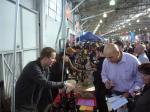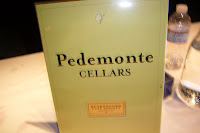By Mac McCarthy
SavvyTaste
For its 6th year, the East Bay Vintners Alliance hosted its Urban Wineries public tasting event for 18 small, in some cases boutique, wineries, all from the San Francisco East Bay communities of Oakland, Berkeley, Albany, and Alameda. And once again they proved that fine, top-notch wines can be produced in an urban environment of former aircraft hangers, submarine repair depots, and light-industrial buildings.
(The group also hosts a visit-the-wineries version of this event in the Spring.)
Rather than attempt a run-down of every wine and every winemaker, let's focus on the most notable, tastiest, and most-recommended wines served that sunny August day at Jack London Square. I give prices where I found them.
Blacksmith Cellars' 2009 North Coast Chenin Blanc was a happy surprise to start my day -- I am always on the lookout for a decent American Chenin Blanc -- a grape long used in California to make jug wines, but in the right hands a delicious, bright glass of white delight. Last year, I did not care for Blacksmith's CB effort, but this year's serving was quite delicious! $15. Recommended, especially if you're ready to venture beyond more popular whites.
 |
| Chis Ehrenberg |
Ehrenberg Cellars poured two especially noteworthy big reds: its 2009 Shenandoah Valley Zinfandel -- that's Shenandoah Valley, California, folks -- and a 2009 Lodi Petite Syrah -- Chris Ehrenberg really knows how to turn out a Petite, I'll tell you; this isn't the first excellent vintage of that grape from this guy.
JRE Wines (John Robert Eppler Wines) showed one of those crazy red blends that California's small winemakers seem to love experimenting with, combining unexpected grapes to produce something quite delicious: In the case of their "Petite Rouge" blend of Syrah, Petite Syrah, Cab, and Petit Verdot. An odd mix but -- delicious.
Periscope Cellars, named for its original location in an old WWII submarine repair shop, likewise offered an interesting blend they call Mashup -- odd lots of various grapes, resulting in a taste that grew on me as I sipped. They also had a 2008 Sierra Foothills "Nil's" Cabernet ($40) that was very, very nice -- actually worth the price. (They enjoy funny names for some of their wines: Deep 6, Evil Eye, Yes We Cab!)
R&B Cellars was showing its 2007 (!) Swingsville Zin, which is really great. And somehow the flavor seems to perk up even more when you find out that it's only $12 -- the wine tastes like a much more expensive Zin.
Rock Wall Wines had a killer Zin also: a 2009 Monte Rosso -- a magical vineyard in Zinfandel circles -- and the wine, $30, was indeed magically rich, intense, and delicious in a way only Zinfandel can be. This is Zin made the way Kent Rosenblum makes it at its best (his daughter, Shawna, is the winemaker at Rock Wall and obviously learned a thing or three at her daddy's knee).
Rock Wall also showed off its 2009 Tannat 'Palindrome,' $22, a wine you don't see here very often. The grape is used to make reds and roses in France, and Armagnac brandy. It's often overly tannic, but Rosenblum used the latest technique, micro-oxygenation, in a successful bid to tame the tannins. The result is a dense, killer Big Red -- Shawna told me she heard it described as "Petite Syrah and Syrah on steroids," and that's a good phrase. Zowie! (Shawna kept referring to one of the flavor components as "rose hips" but, as with so many wine-geek tasting terms, I don't know what rose hips taste like, so it's no help to me....)
Rosenblum Cellars offered a 2008 Cullinane Reserve Zinfandel, Sonoma Valley ($45). This has always been one of my favorite Rosenblum Zinfandels (and one of its very first wines), though it's produced in such limited quantities that it's rarely served as such tastings. Lucky me, they served it this time, and it was as I have always remembered: the perfect Zin. Not quite as jammy as a good Rockpile year, but extraordinarily rich, dense, and flavorful. (They actually put a little Petite Syrah in this one, presumably to up the brightness a bit.) You will do yourself a favor if you can acquire a bottle of this stuff, even at that price.
Finally, Stomping Girl was pouring some of the few Pinot Noirs of the day, so its table was crowded, and for good reason. All three of its PNs are tasty: 2009 Lauterbach Hill Vineyard (what an aroma!), 2009 Beresini Vineyard (smooth, with a nice finish), and 2009 Corona Creek Vineyard (aroma, nice finish). Worth searching out.
(Why do I only say "aroma" without characterising it? Because a surprising number of wines simply have no particular aroma at all. They taste great, in many cases, but there's zero nose. So a wine that has nose -- presumably a nice aroma, you understand, rather than a funky one -- is worth making a note. In this case, Pinot Noir
I didn't get a chance to stop by all the booths, but a few days later I went over to Urban Legend and tasted through their selection, with happy results. I'll post about that interesting tasting separately.
And once again we taste the proof that the improbable venue of the East Bay hosts some wonderful wines to compete with the best California offers. It's worth seeking these vintners out on the Web, and if you're in Northern California, it's worth making a pilgrimage to these wineries. Visit the group web site for a list, and maps, and hours (many are open for tasting only on weekends).
And tell 'em Mac sent you.
---------------
FEEDBACK: Above, I refer to a flavor component described as 'rose hips,' which means nothing to me. I often find, among the dozens of flavor words used in high-end wine reviews, few that are helpful, and few that I can detect in the same wine. (I remember one notable reviewer who claimed to taste in one particular wine, among the two-dozen or so elements, 'white tobacco.' I laughed out loud.)
Do you have favorite wine-reviewer terms you find of no value to you, overused, and under-helpful? Share with me in Comments, below!
(And while you're here, sign up for this blog to be alerted to future posts!)
--Mac McCarthy



























